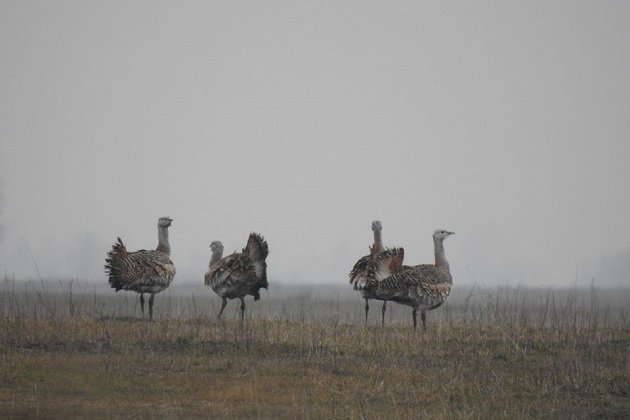
I woke up at 5 am, a good two hours before the sun (and I really hate to be up before the sun). And I had a 100 mile drive ahead of me through the… raining snow? Snowing rain? Fortunately, there was no ice.
I was heading to the international Great Bustard count on St. Valentines. The idea behind is simple, some birds may move and if counted within a week or a month, double counting is almost guaranteed. Yet, it takes great logistical effort to organize the census all the way from Germany to Austria, Hungary and Serbia in the same day, to count on numerous volunteers and hope for the best February weather.
This species has suffered rapid population reductions across most of its range owing to the loss, degradation and fragmentation of its habitat and land-use changes in eastern Europe, says IUCN’s Red List. It therefore qualifies as Vulnerable.
The Association for the Protection of the Great Bustard from Serbia had just about enough counters to cover the Pastures of Great Bustard Special Nature Reserve and the neighbouring areas (birds often spend the winter in arable fields outside the reserve). It was still raining when we started the count, but the visibility wasn’t that bad. The first disappointment came early: the soil was far too soaked for any dirt track driving, even for something as capable as the mighty Hilux. Hence all vehicles – including 4x4s – were restricted to paved roads only.
Habitat loss and fragmentation continues as a result of ploughing of grasslands, intensive grazing, afforestation and increasing development of irrigation schemes, roads, power-lines, fencing and ditches. Mechanisation (ploughing and harvesting in particular), chemical fertilisers and pesticides, fire and predation all contribute to high mortality of eggs, chicks, juveniles and incubating females. Finally, the impacts of climate change may increasingly affect Great Bustards, with harsh winter weather causing adult mortality and heavier summer rainfall leading to loss of clutches (Source: BirdLife International Species Datazone).
 All photos (4) by Istvan Ham
All photos (4) by Istvan Ham
We barely started when Nenad and Jozsi, who were walking along the very muddy dirt track between the fields flushed two Great Bustards. Quickly, all teams in the vicinity were warned of the discovery, so we all drove back to find and observe them.
David Grabovac and I stopped by the roadside, scanned the distant fields and spotted some 15 Roe Deer but no bustards, drove a bit further, scanned the horizon, drove further yet and there they were. Far, but not too far to spot them with binoculars, still, not close enough to study them in detail in a drizzling rain.
Examining them carefully, I notice that the right hand bird has a rufous collar, thick neck, white bristles and more white visible on a folded wing than its neighbour. Now, all that should indicate an adult male – an important find because in some winters we were unable to find a single mature male. Yet, David, who has much more experience with bustards, isn’t convinced: “In winter, some females develop bristles, too.”
About that time, a raptor expert Istvan Ham joined us, and after David and I left to investigate areas closer to the Romanian border, Ham went walking closer to the birds. Later that day, his photos and videos will be hotly analysed and debated.
The rain thankfully stopped. All the teams were wandering around like busy bees, but hadn’t found any other bustards. Afterwards, the Association had organized a lunch for participants, also the chance to collect all the photos we made and project them onto the wall.
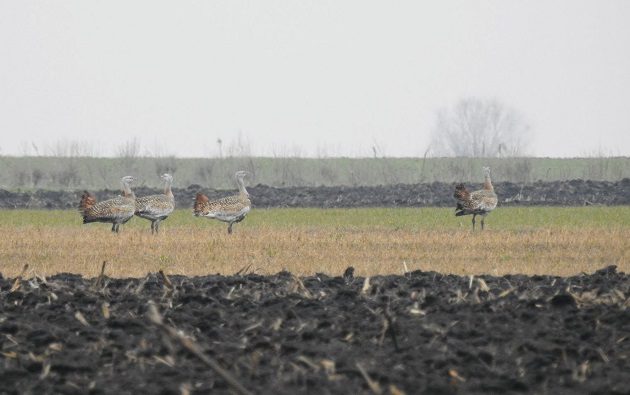
At first, Ham flushed the birds, but they landed next to two other, yet undiscovered bustards, so the tally was four. He climbed a small tree, from where he made several photos and videos shoving birds cocking their tails in the early stage of a display – a typically male behaviour (cover photo).
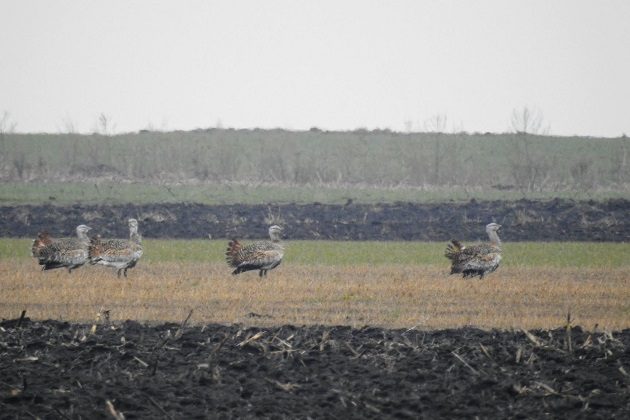
I was quite convinced that at least one of them was a male, but Ham commented that all four were about the same size (the males should be at least 30% larger than females). It seemed that sexing bustards is very tricky and even those far more experienced weren’t sure, but before further studies, most of us, including Ham, agreed that we had one adult and three young males.
Which is good, if it gets confirmed by true bustard experts. How about females? In winter, males and females form separate flocks and females are less prone to wandering. Due to weather conditions, only about 30 per cent of the reserve was covered by car, on foot and from high observation towers. Hence, a flock of females may be there, somewhere, successfully avoiding detection.
Hopefully, we found males (but not the females) and covered one third of the reserve. Being tied to a particular date and facing rain and mud, we did our best, which was not good enough. But, restricted by the number of volunteers combined with the size of the reserve (68 km2 / 26 mi2), even when weather improves we will not be able to organize another large scale count this winter.
What conclusions to draw from this exercise? In the last year, a broken bustard eggshell was found, but since no displaying was observed, those could have been unfertilized eggs. This year we seem to have an adult male in the reserve and we believe that females are there, too, so the hopes are high for a successful breeding season.
Several days later, my high hopes were crushed by Hungarian bustard experts’ judgement, just like that last years’ eggshell: all four birds were females. So, this winter we have 4 females in the reserve (or one third of it) and that is all we can say with certainty. I feel that there must be some more good looking girls to attract some boys from Hungary, but I no longer dare to hope.
Find the part one of this search here





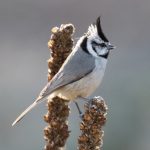
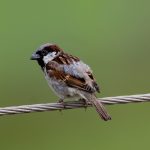


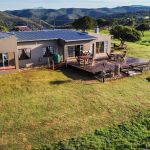
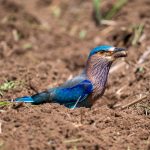

Oh boy. Well, at least you had 4 birds.
I had an opportunity to visit one of our three great bustard areas here in Germany on Monday and spotted a flock of 58. Overall we should have around 300 individuals again in Germany, up from ca. 80 in the early 2000s. So there is always hope if you manage breeding success and predation of nests.
I hope Jochen is correct, that the numbers improve. I felt very sad after reading your two articles. It does sound like quite the adventure.
We covered only one third of the reserve and I do hope that there were more birds then we counted.
The ray of hope is, the other day announced LIFE project includes the construction of the fence that should protect their breeding grounds from hungry foxes and boars
I don’t want to believe that we saw all there was, I remain faithful that there were more than that
And I was actually hoping for some more adventure, some serious off-roading, but two days of rain with snow / snow with rain have put an end to those hopes
Any news regarding other individuals? I just got back from the German breeding grounds, having enjoyed mice views again. So I thought of your post and wondered…
The latest info from the reserve warden, there were no displaying males this spring and there is only one unfertilized egg in the reserve at the moment